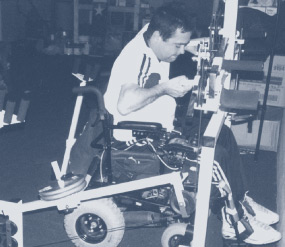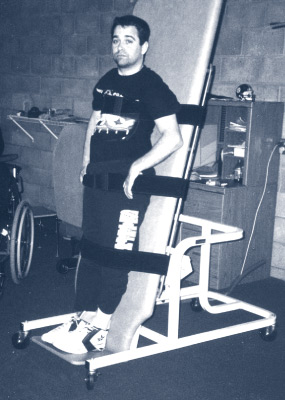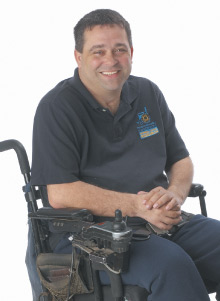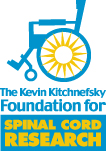

As a quadriplegic, Kevin can’t feel below his chest, so loss of muscle tone and mass can become a real problem. Every day, Kevin has to exercise his muscles – even the ones he cannot normally move. This is done using a series of exercise devices.
He works out with weights, a special exercise-cycle for his arms, a tilt-table so he can stand, and a special bike, called a Regis Bike. The Regis Bike comes with a special pair of exercise pants with electrodes. They electrically stimulate Kevin’s leg muscles, causing them to contract – this moves the muscles and keeps them in shape. If this isn’t done, his muscles would atrophy.
All this exercise is not only good for the muscles themselves, but keeps Kevin’s heart and lungs primed and efficient. It also does wonders for his self-esteem.
Kevin’s Care: A Day in the Life
This narrative was prepared by Kevin’s mother, Yvonne,
to help readers understand the daily challenges of Kevin’s situation. As is a quadriplegic, he doesn’t have full use of either his arms or legs. Kevin’s legs and hands are completely paralyzed, and he has limited use of his arms.
First thing in the morning, we flush his catheter, to help prevent him from getting bladder or kidney stones. We then transfer him to a shower-chair to do a bowel program. It takes up to an hour for it to work. Afterwards, we give him a shower and transfer him back to bed. We rub lotion into his skin to keep it soft and put Carrington cream on the parts of his body that come in contact with the wheelchair, to help prevent skin breakdown (similar to bed sores).
Kevin then does a series of foot exercises and leg stretches. We dress him and transfer him to his wheelchair. When he is fully dressed, it’s important that he not be sitting on any wrinkles or folds in his pants, as this can interrupt his circulation.
Over the course of the day, we make sure he drinks plenty of fluids – mostly water. We also empty his urine bag (which is attached to his leg – and yes, it is visible) several times during the day. We pay close attention to his leg bag – if his catheter gets pinched or twisted so that urine can’t flow into the bag, or if the bag gets full, it can cause serious problems or even death if it’s not taken care of right away.
Sufferers of spinal cord injury generally find preparing their own meals difficult or impossible. As Kevin has limited use of his arms, meals must be prepared for him. He can feed himself only with great difficulty, and sometimes only by using special devices, such as a spoon that attaches to his wrist via an adjustable strap.
We watch Kevin’s body temperature carefully, as he can’t regulate the temperature in the areas of his body that have been paralyzed. If his temperature becomes too extreme, and this can be from something as simple as sitting in the sun for too long or being out on a chilly day, he experiences severe pain in his head. If his temperature is not brought back to normal, he could suffer a heart attack or stroke because his body will begin to shut down.
Bedtime comes early – usually around 8:00pm. We transfer Kevin from his wheelchair to his bed. We get him undressed and check his skin for breakdown. We then rub him down with Carrington cream. His catheter needs to be flushed again, and we change him over from his leg bag to an elevated height bag. We turn him on his side to sleep. To promote circulation, Kevin needs to be turned periodically during the night. A newly injured person needs to be turned every two hours, although someone injured as long as Kevin only needs to be turned every four hours.
As you can imagine, the level of constant care and supervision is incredible demanding on Kevin and his caregivers. In addition to his family, he is fortunate to always have a full-time, professional aide by his side.






